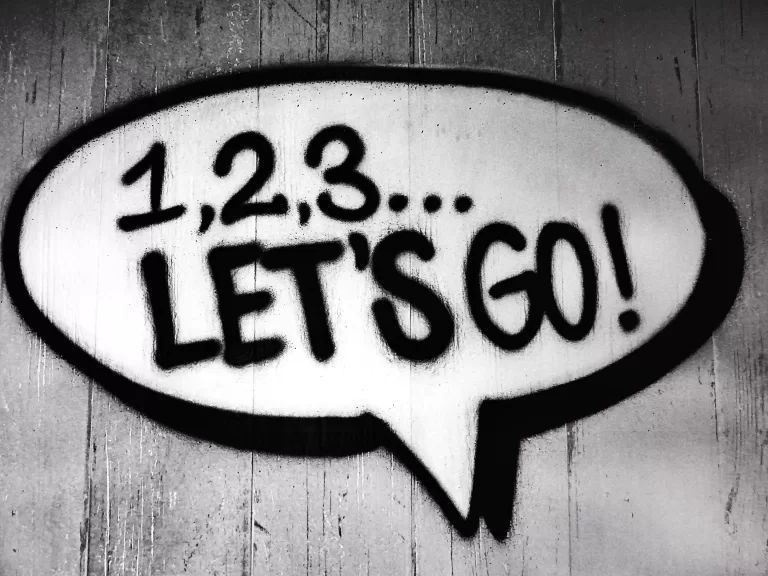Trending Today
Get the Tips: Marketing
for 7-Figure Growth
for 7-Figure Growth
Get solid marketing strategies, designed for entrepreneurs on the track to 7-figures and beyond, right in your inbox.

We had a client who owned a local ballroom dance studio situated in a strip mall. We recognized the potential to market to the existing foot traffic beyond the immediate neighboring store. After obtaining approval from the shopping center management and ensuring legal compliance, we initiated our plan.
We crafted large poster board stencils shaped like dance step guides with footprints and used temporary spray paint to apply a series of these steps along the sidewalk outside the stores, leading to the studio. The steps were sized and spaced for actual dancing, so that prospects could dance their way all the way to the studio. Interspersed among the steps, we included the studio logo, directional arrows, phone numbers, QR codes, and special offers.
This approach integrated several key aspects of guerilla marketing: targeting an existing audience, engaging multiple senses, being interactive, raising brand awareness, and offering incentives.
Over a single month, the studio experienced a substantial increase in foot traffic, as well as a 357% rise in phone inquiries and a 1321% surge in website visits. After the month that we had agreed to with the shopping center management, we removed the temporary design, and then created a similar campaign six months later with a Valentine’s Day theme, footsteps that were obviously meant for a couple, and even more impressive results.

Here’s a few of the well-known ideas to help get you started brainstorming. Keep in mind, since each of these are sort of common, they can also be sort of boring.
Create eye-catching, temporary sidewalk chalk art to promote your business. Use bright colors and unique designs to grab the attention of passersby. Include your logo, website, and social media handles to encourage further engagement. For instance, a local bakery could draw attention to their grand opening with an elaborate chalk art display, showcasing their delectable creations and inviting passersby to visit.
Pop-up Events
Host a pop-up event in a high-traffic area to generate interest in your business. Collaborate with other local businesses to create a fun and engaging atmosphere. Offer exclusive discounts, samples, or giveaways to entice potential customers. A boutique clothing store, for example, could partner with a local cafe and host a pop-up fashion show, drawing in customers for both businesses.
Local Sponsorships
Partner with a local event, sports team, or charity and offer your products or services as sponsorship. This not only boosts your brand’s visibility but also demonstrates your commitment to the community. A fitness center might sponsor a local charity run, offering free training sessions for participants and promoting their brand through banners and merchandise.
Flash Mobs
Organize a flash mob to promote your business in a fun and unforgettable way. Ensure the performance ties into your brand and message, and capture the event on video to share on social media. An example could be a bookstore organizing a flash mob where participants freeze in place, reading a book, drawing attention to the store’s offerings and creating shareable content.
It’s important to keep in mind that not all of these activities mentioned will be right for all businesses. The key is finding an idea that directly relates to your business – which is what will make it more memorable and attention-worthy.
To create an effective guerilla marketing campaign, keep these key factors in mind:
Relevance: Ensure your campaign aligns with your product or service, as well as your target audience. Tailor your tactics to your specific industry and customer base, keeping their needs and preferences in mind.
Location: Identify where your ideal customer is likely to be, whether it’s physically, online, or elsewhere, and tailor your campaign accordingly. Select high-traffic areas or popular online platforms where your message can reach the most potential customers.
Goals: Establish clear objectives for your campaign to help guide its design and measure its success. Set specific, measurable goals related to foot traffic, inquiries, or online engagement to track your progress.
To generate unique guerilla marketing ideas that suit your business, consider the following pieces to include in your brainstorming.
Understand your target audience’s demographics, interests, and habits. This knowledge can inspire creative marketing tactics that resonate with your customers.
For example, the flash mob we mentioned above won’t be right for all audiences. But maybe you’re an apparel store that caters to teens that go to one specific local high school. A flash mob made of up some of these students wearing your tops, combined with some of the cheerleaders and football players who are wearing their uniforms, that takes place in a mall (where prospective shoppers already are) could be memorable, since you’re connecting both to the location, to your audience (whose parents will probably show up to watch – and they’re likely the final decision makers), you’re integrating the teen shoppers and engaging with them, and your logo will be displayed prominently on the shirts they wear and near your store.
You need to really know your audience to find the right event.
Examine your competitors’ marketing strategies, identifying both their strengths and weaknesses. Look for opportunities to stand out by offering something different or filling a gap in the market.
Collaborate with team members or other local businesses to brainstorm innovative ideas. Leverage their unique perspectives and experiences to create a diverse range of marketing strategies.
Look for inspiration outside your industry, exploring successful guerilla marketing campaigns in other sectors. Adapt and modify these ideas to suit your specific business needs.
Consider your community’s unique characteristics, events, and trends to create locally relevant campaigns. This can help foster a connection with your audience and demonstrate your commitment to the community.
It’s essential to track the results of your guerilla marketing campaign to determine its effectiveness. You should have set some goals, which will let you know what to track. Monitor key performance indicators (KPIs) such as foot traffic, phone inquiries, website visits, and social media engagement. Analyze these metrics to identify areas of success and improvement, and adjust your strategies accordingly.

Vicky is the CEO and Chief Creative Strategist of Vicky Wu Marketing. She draws from 30 years of experience at the CMO level, the CEO level, marketing for Fortune 500 companies and multi-million and multi-billion-dollar organizations, PLUS strategies learned helping startups and nonprofits with limited budgets … now focusing on providing SMBs with effective and efficient marketing strategies – giving them access to the same level of expertise as the really big guys with deep pockets, that they may not otherwise be able to access.
Get solid marketing strategies, designed for entrepreneurs on the track to 7-figures and beyond, right in your inbox.

